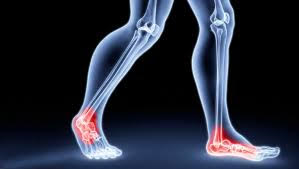In the U.S. 25,000 Americans sprain their ankles every day. While Canada’s population is smaller, even north of the border it remains the most commonly injured joint within the human body. There are 26 bones in the human foot, 33 joints and over 100 muscles, tendons and ligaments that hold the bones together and move the foot in all directions. This multi-directional motion makes the ankle inherently unstable. Adding the weight of the body on to it makes the ankle especially vulnerable to injury. Ligaments are strong, fibrous bands of tissue that support and stabilize joints. When these ligaments are overly extended past their natural range of motion from an incorrect landing or turning while the foot is planted, these ligaments can be overly stretched or torn. The most common ankle sprain is the result of an over inversion, or exaggerated inward motion of the ankle, otherwise known as a lateral ankle sprain. The ligaments most commonly affected in this type of ankle sprain are the talofibular and the calcaneofibular ligaments; two bands on the outside of the ankle. With all that damage, the ankle will swell, get red and of course hurt. Unfortunately when this happens we often treat these symptoms as if they are a negative consequence of the injury because they are unpleasant. Nothing is further from the truth. Pain and swelling is the result of increased fluid and white blood cells moving into and around the injured site to start the healing process. This also serves to protect and stabilize the ankle to prevent further injury. Redness is the result of increased blood flow carrying precious platelets to further aid in the repair process.
foot, 33 joints and over 100 muscles, tendons and ligaments that hold the bones together and move the foot in all directions. This multi-directional motion makes the ankle inherently unstable. Adding the weight of the body on to it makes the ankle especially vulnerable to injury. Ligaments are strong, fibrous bands of tissue that support and stabilize joints. When these ligaments are overly extended past their natural range of motion from an incorrect landing or turning while the foot is planted, these ligaments can be overly stretched or torn. The most common ankle sprain is the result of an over inversion, or exaggerated inward motion of the ankle, otherwise known as a lateral ankle sprain. The ligaments most commonly affected in this type of ankle sprain are the talofibular and the calcaneofibular ligaments; two bands on the outside of the ankle. With all that damage, the ankle will swell, get red and of course hurt. Unfortunately when this happens we often treat these symptoms as if they are a negative consequence of the injury because they are unpleasant. Nothing is further from the truth. Pain and swelling is the result of increased fluid and white blood cells moving into and around the injured site to start the healing process. This also serves to protect and stabilize the ankle to prevent further injury. Redness is the result of increased blood flow carrying precious platelets to further aid in the repair process.
Dr. Dave’s top 5 list of things to do after you sprain your ankle:
- Keep it moving! Resting it too much can stiffen the joint and delay rehabilitation.
- Exercise. Starting with light resistance, and increase the load over the coming weeks. This improves circulation, and places necessary stressors on the ligaments to ensure proper issue alignment during the maturation phase of tissue healing.
- Pain medication. Tylenol, Meriva-HP(29 times more bio-available than other curcumin products). Avoid NSAIDS.
- Diet and supplementation. Protein(.8g/kg body weight). Meat and eggs contain the highest amount. Collagen powder, Vitamin A(25,000 IU/day), High Potency B-Complex daily, Vitamin C(2g/day), Zinc(30g/day) AR-Encap(1 cap 4 times daily), greens powder. All these elements are crucial in collagen production and general wound healing.
- PRP/Prolotherapy: A highly effective regenerative technique that stimulates the body’s own immune system and platelets to accelerate healing.
